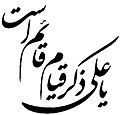Persian calligraphy
| Part of a series on |
| Calligraphy |
|---|
 |
Persian calligraphy (Persian: خوشنویسیِ فارسی) is the calligraphy of the Persian writing system. It is one of the most revered arts throughout Persian history.
History

History of Nas’taliq
After the introduction of Islam in the 7th century, Persians adapted the Arabic alphabet to Persian and developed the contemporary Persian alphabet. The Arabic alphabet has 28 characters. An additional four letters were added by Iranians [2], which resulted in the 32 letters currently present in the Persian alphabet.
Around one thousand years ago, Ibn Muqlah (Persian: ابنِ مقله بيضاوی شيرازی) and his brother created six genres of Iranian calligraphy, namely "Tahqiq", "Reyhan", "Sols", "Naskh", "Toqi" and "Reqa". These genres were common for four centuries in Persia. In the 7th century (Hijri calendar), Hassan Farsi Kateb combined the "Naskh" and "Reqah" styles and invented a new genre of Persian calligraphy named "Ta'liq". In the 14th century, Mir Ali Tabrizi combined two major scripts of his time, i.e. Naskh and Taliq, and created a new Persian calligraphic style called "Nas’taliq"[2]. In the past 500 years Nastaʿlīq (also anglicized as Nastaleeq; Persian: نستعلیق nastaʿlīq) has been the predominant style for writing the Perso-Arabic script.
History of cursive Nas'taliq
In the 17th century Morteza Gholi Khan Shamlou and Mohammad Shafi Heravi created a new genre called cursive Nastaʿlīq Shekasteh Nastaʿlīq (Persian: شکسته نستعلیق). Almost a century later, Abdol-Majid Taleqani, who was a prominent artist at the time, brought this genre to its highest level. This calligraphic style is based on the same rules as Nas’taliq. However, cursive Nas’taliq has a few significant differences: it provides more flexible movements, and it is slightly more stretched and curved. Yadollah Kaboli is one of the most prominent contemporary calligraphers within this style.
-
Persian calligraphy.
-
Folio of Poetry From the Divan of Sultan Husayn Mirza, ca. 1490. Brooklyn Museum.
-
Calligraphy of Persian poems on large pishtaq
-
Chalipa panel, Mir Emad.
Contemporary Persian calligraphy
In 1950, the Iran's Association of Calligraphers was founded by Hossein Mirkhani, Ali Akbar Kaveh, Ebrahim Bouzari, Hassan Mirkhani and Mehdi Baiani. For an overview of Persian calligraphy's development within Afghanistan, see "Calligraphy during last two centuries in Afghanistan" (1964), by Azizuddin Vakili.
Modernist movement
Zendeh Roudi, Jalil Rasouli, Parviz Tanavoli, and Nima Behnoud use Persian calligraphy and Rumi poetry in dress designing.
Genres
- Nasta'liq script
- Shekasteh Nastaʿlīq (Cursive Nasta'liq)
- Naghashi-khat (Painting-Calligraphy combined)
Most notable figures
This article needs additional citations for verification. (August 2015) |




